| Common name | Binomial name | Population | Status | Trend | Notes | Image |
|---|
| Javan lapwing | Vanellus macropterus | 0-49 [17] | CR [17] |  [17] [17] | Last confirmed sighted was in 1939. [17] |  |
| Eskimo curlew | Numenius borealis | 0-49 [18] | CR [18] | Unknown [18] | Last confirmed sighting in 1960s. [18] |  |
| Slender-billed curlew | Numenius tenuirostris | 1-49 [19] | CR |  [19] [19] | No recent sightings; may be extinct. [19] | 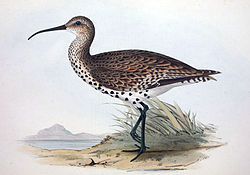 |
| Black stilt | Himantopus novaezelandiae | 1-49 [20] | CR [20] |  [20] [20] | Estimate is for mature individuals only. [20] |  |
| New Caledonian buttonquail | Turnix novaecaledoniae | 1-49 [21] | CR [21] | Unknown [21] | May be extinct. Last sighting was in early 1900s. [21] | |
| Buff-breasted buttonquail | Turnix olivii | 1-250 [22] | CR [22] | Unknown [22] | Best estimate is 1-49 mature individuals. May be extinct; last verifiable sighting was in the 1920s. [22] |  |
| Brown-chested lapwing | Vanellus superciliosus | 1-25,000 [23] | LC [23] | Unknown [23] | Tentatively equal to 10,000-19,999. Wide estimate comes from uncertainty of threats to species. [23] |  |
| Chinese crested tern | Thalasseus bernsteini | 30-49 [24] | CR [24] |  [24] [24] | |  |
| Jerdon's courser | Rhinoptilus bitorquatus | 70-400 [25] | CR [25] |  [25] [25] | Equal to 50-249 mature individuals. [25] |  |
| New Zealand plover | Charadrius obscurus | 120 [26] | CR [26] |  [26] [26] | Equal to 60-80 mature individuals. [26] | 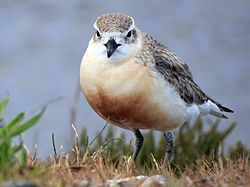 |
| Shore dotterel | Thinornis novaeseelandiae | 170 [27] | EN [27] |  [27] [27] | Estimate for mature individuals only. Recent estimates found breeding populations to be 85 pairs. [27] | 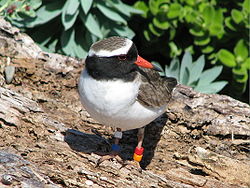 |
| Chatham oystercatcher | Haematopus chathamensis | 200-249 [28] | EN [28] |  [28] [28] | Estimate is for mature individuals only. [28] |  |
| Spoon-billed sandpiper | Calidris pygmaea | 240-620 [29] | CR [29] |  [29] [29] | Estimate for mature individuals only. Best estimate is 490 mature individuals. [29] |  |
| Plains-wanderer | Pedionomus torquatus | 251-1,000; 5,000 [30] | EN [30] |  [30] [30] | Minimum and maximum estimates are for mature individuals only. There is much uncertainty regarding the estimate. [30] | 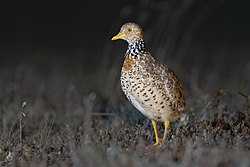 |
| Australian painted-snipe | Rostratula australis | 270-410 [31] | EN [31] |  [31] [31] | Best estimate is of 340 mature individuals. [31] | 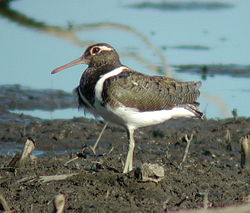 |
| Saint Helena plover | Charadrius sanctaehelenae | 545 [32] | CR [32] |  [32] [32] | Estimate is exact count from a recent survey for mature individuals only. [32] |  |
| Black-bellied tern | Sterna acuticauda | 900-1,100 [33] | EN [33] |  [33] [33] | Estimate for mature individuals only. Broader range of population estimated at 800–1,600. The estimate to the left is the best available. Species needs further study due to severe declines in population in recent decades. [33] |  |
| Lava gull | Larus fuliginosus | 900-1,200 [34] | VU [34] |  [34] [34] | Equal to 600-800 mature individuals. May be an overestimate. [34] |  |
| Madagascar jacana | Actophilornis albinucha | 975-2,064 [35] | EN [35] |  [35] [35] | Equal to 780–1,643 mature individuals. [35] |  |
| Snares island snipe | Coenocorypha huegeli | 1,000-1,500 [36] | NT [36] |  [36] [36] | Estimate is for mature individuals only. [36] | 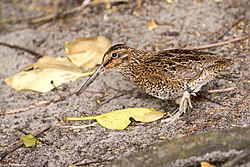 |
| Nordmann's greenshank | Tringa guttifer | 1,000-2,000 [37] | EN [37] |  [37] [37] | Equal to 600–1,300 mature individuals. [37] | 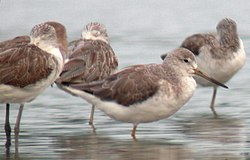 |
| Peruvian tern | Sternula lorata | 1,000-2,499 [38] | EN [38] |  [38] [38] | Equal to 667–1,666 mature individuals. [38] |  |
| Black-fronted tern | Chlidonias albostriatus | 1,000-5,000 [39] | EN [39] |  [39] [39] | Estimate for mature individuals only. [39] |  |
| Andean lapwing | Vanellus resplendens | 1,000-10,000 [40] | LC [40] |  [40] [40] | Equal to 670–6,700 mature individuals. [40] |  |
| Belcher's gull | Larus belcheri | 1,000-10,000 [41] | LC [41] |  [41] [41] | |  |
| Snowy-crowned tern | Sterna trudeaui | 1,000-10,000 [42] | LC [42] |  [42] [42] | Equal to 670–6,700 mature individuals. [42] |  |
| Tawny-throated dotterel | Oreopholus ruficollis | 1,000-10,000 [43] | LC [43] |  [43] [43] | Equal to 670–6,700 mature individuals. [43] |  |
| Long-billed plover | Charadrius placidus | 1,000-25,000 [44] | LC [44] |  [44] [44] | Equal to 670–17,000 mature individuals. [44] |  |
| Tuamotu sandpiper | Prosobonia parvirostris | 1,300 [45] | EN [45] |  [45] [45] | Minimum estimate. Equal to 900 mature individuals. [45] |  |
| Javan plover | Charadrius javanicus | 2,000-6,000 [46] | LC [46] |  [46] [46] | Equal to 1,333-4,000 mature individuals. Population size now considered to be larger. [46] |  |
| Damara tern | Sternula balaenarum | 2,200-5,700 [47] | LC [47] |  [47] [47] | Estimate for mature individuals only. [47] |  |
| Chilean skua | Catharacta chilensis | 2,500-9,999 [48] | LC [48] |  [48] [48] | Estimate for mature individuals only. Tentative estimate. [48] | 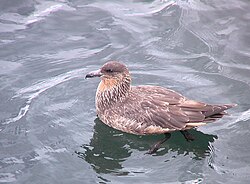 |
| Fairy tern | Sternula nereis | 2,500-9,999 [49] | VU [49] |  [49] [49] | Estimate for mature individuals only. [49] | 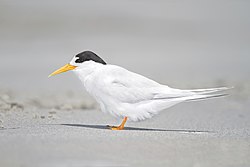 |
| Spot-breasted lapwing | Vanellus melanocephalus | 2,500-9,999 [50] | LC [50] | Unknown [50] | Estimate for mature individuals only. Tentative estimate. [50] |  |
| Diademed plover | Phegornis mitchellii | 2,500-9,999 [51] | NT [51] |  [51] [51] | Equal to 1,667-6,666 mature individuals. [51] |  |
| Fuegian snipe | Gallinago stricklandii | 2,500-9,999 [52] | NT [52] |  [52] [52] | Equal to 1,500-7,000 mature individuals. [52] |  |
| Magellanic plover | Pluvianellus socialis | 2,500-9,999 [53] | NT [53] |  [53] [53] | Equal to 1,667-6,666 mature individuals. [53] |  |
| Madagascar snipe | Gallinago macrodactyla | 2,500-9,999 [54] | VU [54] |  [54] [54] | Estimate is for mature individuals only. [54] |  |
| Chatham snipe | Coenocorypha pusilla | 2,700-3,300 [55] | VU [55] |  [55] [55] | Equal to 1,800-2,200 mature individuals. [55] | 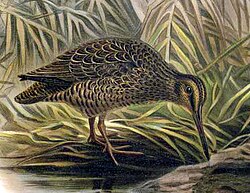 |
| Madagascar plover | Charadrius thoracicus | 2,700-3,500 [56] | VU [56] |  [56] [56] | Equal to 1,800-2,300 mature individuals. [56] |  |
| Black-breasted buttonquail | Turnix melanogaster | 3,000-6,500 [57] | VU [57] |  [57] [57] | Best estimate is 4,800 mature individuals. [57] | 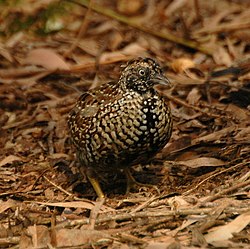 |
| Kerguelen tern | Sterna virgata | 3,500-6,500 [58] | NT [58] |  [58] [58] | Equal to 2,300-4,300 mature individuals. [58] |  |
| Sumba buttonquail | Turnix everetti | 3,500-15,000 [59] | VU [59] |  [59] [59] | Equal to 2,500-9,999 mature individuals. [59] | 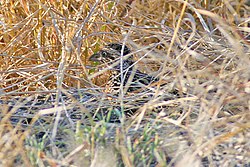 |
| Amami woodcock | Scolopax mira | 3,500-15,000 [60] | VU [60] |  [60] [60] | Equal to 2,500-9,999 mature individuals. [60] |  |
| Wood snipe | Gallinago nemoricola | 3,500-15,000 [61] | VU [61] |  [61] [61] | Equal to 2,500-9,999 mature individuals. [61] |  |
| Indian skimmer | Rynchops albicollis | 3,700-4,400 [62] | EN [62] |  [62] [62] | Equal to 2,450-2,900 mature individuals. [62] |  |
| Variable oystercatcher | Haematopus unicolor | 4,000-4,300 [63] | LC [63] |  [63] [63] | Estimate for mature individuals only. [63] |  |
| Wrybill | Anarhynchus frontalis | 4,500-5,000 [64] | VU [64] |  [64] [64] | Equal to 3,000-3,300 mature individuals. [64] |  |
| Madagascar pratincole | Glareola ocularis | 5,000-10,000 [65] | NT [65] |  [65] [65] | Equal to 3,300-6,700 mature individuals. [65] |  |
| Yellow-wattled lapwing | Vanellus malabaricus | 5,000-10,000 [66] | LC [66] |  [66] [66] | Equal to 3,300-6,700 mature individuals. [66] |  |
| Japanese murrelet | Synthliboramphus wumizusume | 5,200-9,400 [67] | VU [67] |  [67] [67] | Estimate for mature individuals only. [67] | 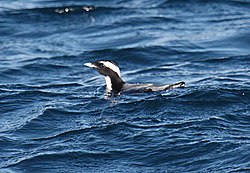 |
| Beach thick-knee | Esacus magnirostris | 6,000 [68] | NT [68] |  [68] [68] | Mature individuals are estimated at 4,000. Subpopulations include 5,000 in Australia, 1,000 in Melanesia islands, and 10–20 in New Caledonia. [68] |  |
| White-fronted tern | Sterna striata | 6,120-25,120 [69] | NT [69] |  [69] [69] | Estimate is for mature individuals only. This estimate includes subspecies S. s. striata and S. s. aucklandorum. [69] | 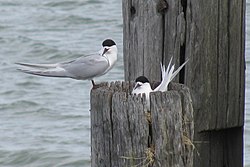 |
| African oystercatcher | Haematopus moquini | 6,670 [70] | LC [70] |  [70] [70] | Equal to 4,450 mature individuals. [70] |  |
| Forbes's plover | Charadrius forbesi | 6,700-67,000 [71] | LC [71] | Unknown [71] | |  |
| Hooded plover | Thinornis cucullatus | 7,000 [72] | VU [72] |  [72] [72] | Estimate for mature individuals only. Split up into two subspecies: 3,000 cucullatus and 4,000 tregellasi. [72] |  |
| Guadalupe murrelet | Synthliboramphus hypoleucus | 7,500 [73] | EN [73] |  [73] [73] | Equal to 5,000 mature individuals. [73] |  |
| Black-winged lapwing | Vanellus melanopterus | 8,700-42,000 [74] | LC [74] |  [74] [74] | Estimate for mature individuals only. [74] |  |
| Moluccan woodcock | Scolopax rochussenii | 9,530-19,059 [75] | VU [75] |  [75] [75] | Estimate is for mature individuals only. [75] |  |
| Olrog's gull | Larus atlanticus | 9,800-15,600 [76] | NT [76] |  [76] [76] | Estimate for mature individuals only. [76] | 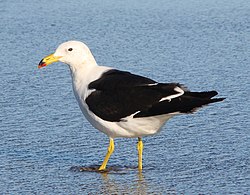 |
| Bristle-thighed curlew | Numenius tahitiensis | 10,000 [77] | NT [77] |  [77] [77] | Estimate is for mature individuals only. [77] |  |
| Imperial snipe | Gallinago imperialis | 10,000 [78] | NT [78] |  [78] [78] | Preliminary minimum estimate. Equal to 6,700 mature individuals. [78] |  |
| Bush thick-knee | Burhinus grallarius | 10,000-15,000 [79] | LC [79] |  [79] [79] | Estimate is for mature individuals only. [79] |  |
| South polar skua | Catharacta maccormicki | 10,000-19,999 [80] | LC [80] |  [80] [80] | Equal to 6,000-15,000 mature individuals. [80] | 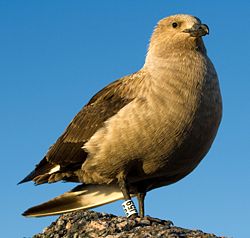 |
| Grey-breasted seedsnipe | Thinocorus orbignyianus | 10,000-25,000 [81] | LC [81] |  [81] [81] | Equal to 6,700-17,000 mature individuals. [81] |  |
| Malaysian plover | Charadrius peronii | 10,000-25,000 [82] | NT [82] |  [82] [82] | Equal to 6,700-17,000 mature individuals. [82] |  |
| Wandering tattler | Tringa incanus | 10,000-25,000 [83] | LC [83] |  [83] [83] | Equal to 6,700-17,000 mature individuals. [83] | 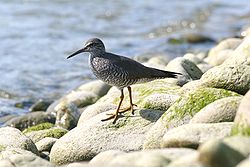 |
| Dolphin gull | Larus scoresbii | 10,000-28,000 [84] | LC [84] |  [84] [84] | Equal to 6,700-19,000 mature individuals. [84] |  |
| Pacific gull | Larus pacificus | 11,000 [85] | LC [85] |  [85] [85] | |  |
| Grey pratincole | Glareola cinerea | 11,000-35,000 [86] | LC [86] | Unknown [86] | Equal to 7,300-23,000 mature individuals. [86] |  |
| Solitary snipe | Gallinago solitaria | 11,000-110,000 [87] | LC [87] |  [87] [87] | Equal to 7,300-73,000 mature individuals. [87] |  |
| Piping plover | Charadrius melodus | 11,500-12,500 [88] | NT [88] |  [88] [88] | Equal to 7,600-8,400 mature individuals. Based on recent census data. [88] |  |
| Craveri's murrelet | Synthliboramphus craveri | 12,000 [89] | VU [89] |  [89] [89] | Equal to 8,000 mature individuals. [89] |  |
| Black-faced sheathbill | Chionis minor | 13,000-20,000 [90] | LC [90] |  [90] [90] | Equal to 8,700-13,000 mature individuals. [90] | 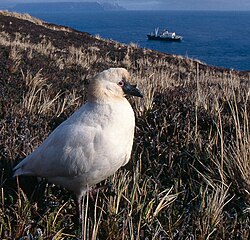 |
| Senegal thick-knee | Burhinus senegalensis | 13,000-33,000 [91] | LC [91] | Unknown [91] | Estimate is for mature individuals only. [91] |  |
| African skimmer | Rynchops flavirostris | 15,000-25,000 [92] | LC [92] |  [92] [92] | Equal to 10,000-17,000 mature individuals. [92] | 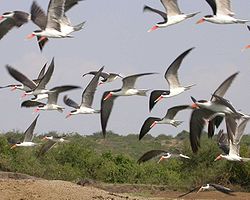 |
| River lapwing | Vanellus duvaucelii | 15,000-29,999 [93] | NT [93] |  [93] [93] | Difficult to estimate. Equal to 10,000-19,999 mature individuals. [93] |  |
| Relict gull | Larus relictus | 15,000-29,999 [94] | VU [94] |  [94] [94] | Equal to 10,000-19,999 mature individuals. [94] |  |
| Scripps's murrelet | Synthliboramphus scrippsi | 15,000-30,000 [95] | VU [95] |  [95] [95] | Equal to 10,000-19,999 mature individuals. [95] |  |
| Egyptian plover | Pluvianus aegyptius | 15,000-57,000 [96] | LC [96] |  [96] [96] | Estimate for mature individuals only. [96] | 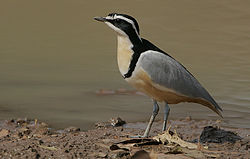 |
| Sociable lapwing | Vanellus gregarius | 16,000-17,000 [97] | CR [97] |  [97] [97] | Population from extrapoplating estimation in Kazakhstan. Equal to 11,200 mature individuals. [97] | 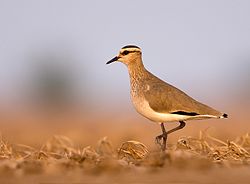 |
| Chestnut-banded plover | Charadrius pallidus | 17,500-22,500 [98] | LC [98] |  [98] [98] | Equal to 11,500-14,900 mature individuals. South African subpopulation estimated at 11,000-16,000 individuals. [98] |  |
| Double-banded plover | Charadrius bicinctus | 19,000 [99] | NT [99] |  [99] [99] | Equal to 13,000 mature individuals. [99] |  |
| Mountain plover | Charadrius montanus | 20,000 [100] | NT [100] |  [100] [100] | Estimate for mature individuals only. [100] |  |
| Latham's snipe | Gallinago hardwickii | 20,000-39,000 [101] | NT [101] |  [101] [101] | Estimate is for mature individuals only. [101] |  |
| Eastern curlew | Numenius madagascariensis | 20,000-49,999 [102] | EN [102] |  [102] [102] | |  |
| Auckland snipe | Coenocorypha aucklandica | 20,000-49,999 [103] | NT [103] |  [103] [103] | Estimate is for mature individuals only. [103] |  |
| White-tailed lapwing | Vanellus leucurus | 20,000-130,000 [104] | LC [104] | Unknown [104] | European subpopulation estimated at 1,100-10,200 mature individuals. [104] |  |
| Saunders's gull | Saundersilarus saundersi | 21,000-22,000 [105] | VU [105] |  [105] [105] | Equal to 14,400 mature individuals. [105] |  |
| Asian dowitcher | Limnodromus semipalmatus | 23,000 [106] | NT [106] |  [106] [106] | |  |
| Buff-breasted sandpiper | Calidris subruficollis | 23,000-84,000 [107] | NT [107] |  [107] [107] | Equal to 15,300-56,000 mature individuals. [107] |  |
| Snowy plover | Charadrius nivosus | 24,000-31,000 [108] | NT [108] |  [108] [108] | Estimate for mature individuals only. [108] |  |
| Grey gull | Larus modestus | 25,000 [109] | LC [109] |  [109] [109] | | 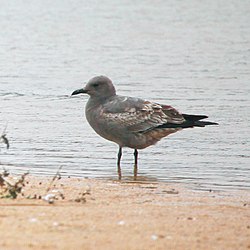 |
| Long-toed stint | Calidris subminuta | 25,000 [110] | LC [110] | Unknown [110] | Minimum estimate. [110] |  |
| White tern | Gygis alba | 25,000-49,999 [111] | LC [111] |  [111] [111] | Estimate is for mature individuals only. [111] | 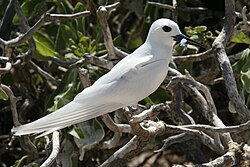 |
| Grey-headed lapwing | Vanellus cinereus | 25,000-100,000 [112] | LC [112] |  [112] [112] | |  |
| Pectoral sandpiper | Calidris melanotos | 25,000-100,000 [113] | LC [113] |  [113] [113] | |  |
| Ross's gull | Rhodostethia rosea | 25,000-100,000 [114] | LC [114] | Unknown [114] | Equal to 15,000-70,000 mature individuals. [114] | 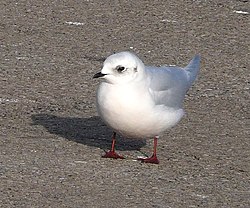 |
| Swinhoe's snipe | Gallinago megala | 25,000-100,000 [115] | LC [115] | Unknown [115] | | 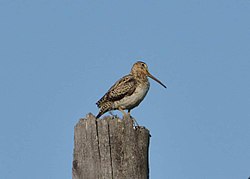 |
| Australian gull-billed tern | Gelochelidon macrotarsa | 25,000-100,000 [116] | LC [116] | Unknown [116] | |  |
| Slaty-backed gull | Larus schistisagus | 25,000-1,000,000 [117] | LC [117] | Unknown [117] | |  |
| Blue noddy | Anous ceruleus | 27,000-120,000 [118] | LC [118] |  [118] [118] | Population combined with Anous albivitta . [118] | 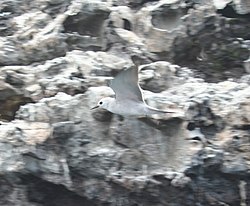 |
| Great skua | Stercorarius skua | 30,000-39,999 [119] | LC [119] |  [119] [119] | Estimate for mature individuals only. [119] |  |
| River tern | Sterna aurantia | 30,000-100,000 [120] | VU [120] |  [120] [120] | Equal to 20,000-70,000 mature individuals. [120] |  |
| Blackish oystercatcher | Haematopus ater | 30,900-131,000 [121] | LC [121] | Unknown [121] | Equal to 20,900-87,300 mature individuals. Subspecies populations include H. a. ater at 22,000-120,000 individuals and H. a. bachmani at 8,900-87,300 individuals. [121] |  |
| Aleutian tern | Onychoprion aleuticus | 31,000 [122] | VU [122] |  [122] [122] | Estimate for mature individuals only. [122] |  |
| Greater painted-snipe | Rostratula benghalensis | 31,000-1,000,000 [123] | LC [123] |  [123] [123] | Estimate is for mature individuals only. [123] |  |
| Audouin's gull | Larus audouinii | 33,000-46,000 [124] | VU [124] |  [124] [124] | Estimate is for mature individuals only. [124] | 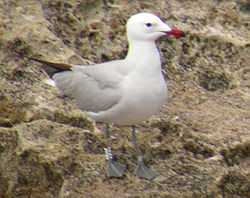 |
| Fynbos buttonquail | Turnix hottentottus | 33,206-132,169 [125] | LC [125] |  [125] [125] | Equal to 22,248-88,553 mature individuals. Estimate calculated from population density and range of habitat. [125] |  |
| Swallow-tailed gull | Creagrus furcatus | 35,000 [126] | LC [126] | Unknown [126] | Last estimate was made in 1984. [126] |  |
| Brown skua | Catharacta antarctica | 39,000-42,000 [127] | LC [127] |  [127] [127] | Equal to 26,000-28,000 mature individuals. [127] |  |
| Caspian plover | Charadrius asiaticus | 40,000-55,000 [128] | LC [128] |  [128] [128] | |  |
| Grey-tailed tattler | Tringa brevipes | 44,000 [129] | NT [129] |  [129] [129] | Equal to 29,500 mature individuals. [129] |  |
| Kittlitz's murrelet | Brachyramphus brevirostris | 48,000-82,000 [130] | NT [130] |  [130] [130] | Equal to 32,000-55,000 mature individuals. [130] |  |
| Red-wattled lapwing | Vanellus indicus | 50,000-60,000 [131] | LC [131] | Unknown [131] | European subpopulation estimated at 100-200 mature individuals. [131] |  |
| Long-billed curlew | Numenius americanus | 50,000-123,000 [132] | LC [132] |  [132] [132] | |  |
| Eurasian dotterel | Eudromias morinellus | 50,000-220,000 [133] | LC [133] |  [133] [133] | | 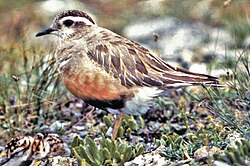 |
| Collared plover | Charadrius collaris | 50,000-499,999 [134] | LC [134] |  [134] [134] | Estimate for mature individuals only. [134] |  |
| Magellanic snipe | Gallinago magellanica | 50,000-1,027,000 [135] | LC [135] |  [135] [135] | Estimate for mature individuals only. [135] |  |
| Pintail snipe | Gallinago stenura | 50,000-2,000,000 [136] | LC [136] | Unknown [136] | European subpopulation is 4,000-10,000 mature individuals. [136] |  |
| Elegant tern | Thalasseus elegans | 51,000-90,000 [137] | NT [137] |  [137] [137] | |  |
| White-eyed gull | Larus leucophthalmus | 53,700-56,700 [138] | LC [138] |  [138] [138] | Equal to 35,800-37,800 mature individuals. [138] |  |
| Ivory gull | Pagophila eburnea | 58,000-78,000 [139] | NT [139] |  [139] [139] | Equal to 38,000-52,000 mature individuals. [139] |  |
| Yellow-footed gull | Larus livens | 60,000 [140] | LC [140] | Unknown [140] | Equal to 40,000 mature individuals. [140] |  |
| Sharp-tailed sandpiper | Calidris acuminata | 60,000-120,000 [141] | VU [141] |  [141] [141] | Best estimate is 73,000 mature individuals. [141] |  |
| Armenian gull | Larus armenicus | 68,000-110,000 [142] | LC [142] |  [142] [142] | Equal to 45,000-73,000 mature individuals. European subpopulation estimated at 44,400-71,800 mature individuals. [142] | 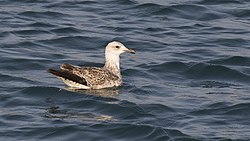 |
| African three-branded plover | Charadrius tricollaris | 70,000-140,000 [143] | LC [143] | Unknown [143] | |  |
| Broad-billed sandpiper | Limicola falcinellus | 71 000 – 160 000 [144] | LC [144] |  [144] [144] | | 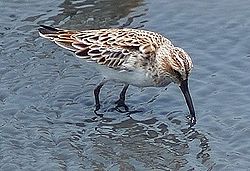 |
| Hudsonian godwit | Limosa haemastica | 77,000 [145] | LC [145] |  [145] [145] | Estimate is for mature individuals only. [145] |  |
| Broad-billed sandpiper | Calidris falcinellus | 86,000-89,000 [146] | LC [146] |  [146] [146] | European subpopulation estimated at 59,400-88,200 mature individuals. [146] |  |
| Black-billed gull | Larus bulleri | 90,000-121,000 [147] | NT [147] | Unknown [147] | Estimate for mature individuals only. [147] |  |
| Little gull | Larus minutus | 97,000-270,000 [148] | LC [148] |  [148] [148] | European subpopulation estimated at 47,400-90,500 mature individuals. [148] | 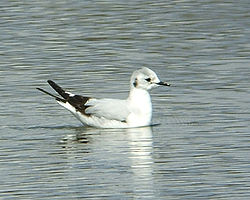 |
| Whiskered auklet | Aethia pygmaea | 100,000 [149] | LC [149] |  [149] [149] | Minimum estimate. Equal to 67,000 mature individuals. [149] |  |
| Pheasant-tailed jacana | Hydrophasianus chirurgus | 100,000 [150] | LC [150] |  [150] [150] | Minimum estimate. [150] |  |
| Chestnut-backed buttonquail | Turnix castanotus | 100,000 [151] | LC [151] |  [151] [151] | Equal to 50,000 mature individuals. This is a possible estimate- no real data to support these number. [151] |  |
| Brown-headed gull | Larus brunnicephalus | 100,000-200,000 [152] | LC [152] |  [152] [152] | | 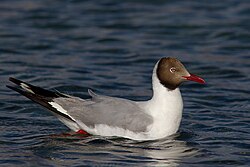 |
| Kentish plover | Charadrius alexandrinus | 100,000-499,999 [153] | LC [153] |  [153] [153] | Preliminary estimate for mature individuals only. [153] |  |
| Iceland gull | Larus glaucoides | 100,000-499,999 [154] | LC [154] |  [154] [154] | European subpopulation estimated at 150,000-300,000 individuals. [154] |  |
| South American snipe | Gallinago paraguaiae | 100,000-499,999 [155] | LC [155] |  [155] [155] | Tentative estimate for mature individuals only. [155] | 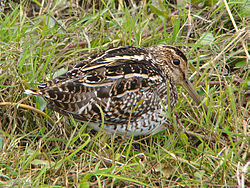 |
| Red-legged kittiwake | Rissa brevirostris | 100,000-499,999 [156] | VU [156] |  [156] [156] | Estimate is for mature individuals only. [156] |  |
| Grey-backed tern | Onychoprion lunatus | 100,000-1,000,000 [157] | LC [157] |  [157] [157] | |  |
| Spotted redshank | Tringa erythropus | 110,000-270,000 [158] | LC [158] |  [158] [158] | European subpopulation estimated at 41,000-108,000 mature individuals. [158] |  |
| South island oystercatcher | Haematopus finschi | 113,000 [159] | LC [159] |  [159] [159] | Equal to 50,000-99,999 mature individuals. [159] |  |
| Western gull | Larus occidentalis | 115,500-118,500 [160] | LC [160] |  [160] [160] | | 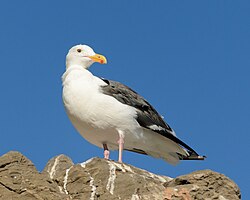 |
| Forster's tern | Sterna forsteri | 120,000 [161] | LC [161] |  [161] [161] | | 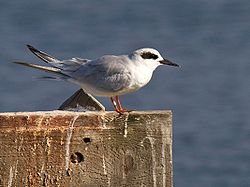 |
| Pallas's gull | Ichthyaetus ichthyaetus | 125,000-1,100,000 [162] | LC [162] |  [162] [162] | |  |
| Spur-winged lapwing | Vanellus spinosus | 130,000-800,000 | LC [163] |  [163] [163] | European subpopulation estimated at 2,100-3,200 mature individuals. [163] |  |
| Spectacled guillemot | Cepphus carbo | 140,000-148,000 [164] | LC [164] |  [164] [164] | |  |
| Solitary sandpiper | Tringa solitaria | 150,000 [165] | LC [165] |  [165] [165] | |  |
| Inca tern | Larosterna inca | 150,000 [166] | NT [166] |  [166] [166] | Minimum estimate. [166] | 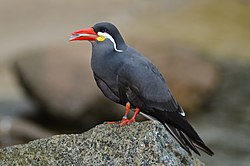 |
| Black-winged pratincole | Glareola nordmanni | 150,000-190,000 [167] | NT [167] |  [167] [167] | Estimate for mature individuals only. [167] | 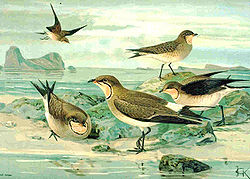 |
| Sooty gull | Larus hemprichii | 150,000-300,000 [168] | LC [168] |  [168] [168] | |  |
| Greater sand plover | Charadrius leschenaultii | 150,000-340,000 [169] | LC [169] |  [169] [169] | Equal to 100,000-225,000 mature individuals. European subpopulation estimated at 1,200-2,000 mature individuals. [169] |  |
| Greater crested tern | Thalasseus bergii | 150,000-1,100,000 [170] | LC [170] |  [170] [170] | |  |
| Oriental plover | Charadrius veredus | 160,000 [171] | LC [171] | Unknown [171] | |  |
| Rock sandpiper | Calidris ptilocnemis | 160,000-170,000 [172] | LC [172] |  [172] [172] | |  |
| Collared pratincole | Glareola pratincola | 160,000-600,000 [173] | LC [173] |  [173] [173] | European subpopulation estimated at 15,700-29,900 mature individuals. [173] |  |
| Terek sandpiper | Xenus cinereus | 160,000-1,200,000 [174] | LC [174] |  [174] [174] | European subpopulation estimated at 30,900-101,000 mature individuals. [174] |  |
| Temminck's stint | Calidris temminckii | 165,000-1,255,000 [175] | LC [175] | Unknown [175] | Equal to 110,000-850,000 mature individuals. European subpopulation is 116,000-333,000 mature individuals. [175] |  |
| Little curlew | Numenius minutus | 180,000 [176] | LC [176] |  [176] [176] | Minimum estimate. [176] | 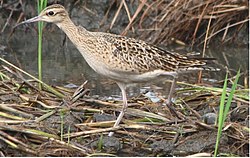 |
| Pacific golden plover | Pluvialis fulva | 190,000-250,000 [177] | LC [177] |  [177] [177] | | 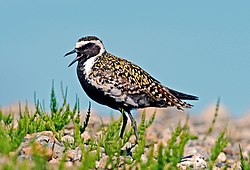 |
| Little tern | Sternula albifrons | 190,000-410,000 [178] | LC [178] |  [178] [178] | European subpopulation estimated at 71,900-106,000 mature individuals. [178] |  |
| Roseate tern | Sterna dougallii | 200,000-220,000 [179] | LC [179] | Unknown [179] | European subpopulation estimated at 4,500-5,800 mature individuals. [179] | 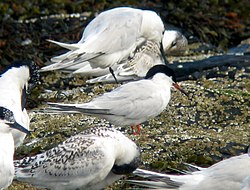 |
| Purple sandpiper | Calidris maritima | 200,000-299,999 [180] | LC [180] |  [180] [180] | European subpopulation estimated at 113,000-166,000 mature individuals. [180] | 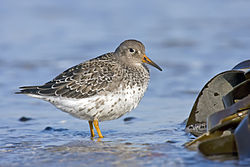 |
| American golden plover | Pluvialis dominica | 200,000 [181] | LC [181] |  [181] [181] | Minimum estimate. [181] | 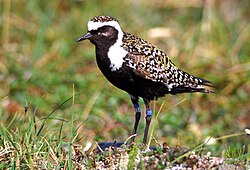 |
| Pigeon guillemot | Cepphus columba | 235,000 [182] | LC [182] |  [182] [182] | | 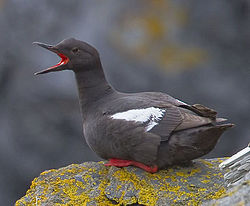 |
| Mediterranean gull | Larus melanocephalus | 236,000-650,000 [183] | LC [183] |  [183] [183] | Estimate for mature individuals only. [183] |  |
| Caspian tern | Sterna caspia | 250,000-470,000 [184] | LC [184] |  [184] [184] | European subpopulation estimated at 23,600-29,600 mature individuals. [184] |  |
| Long-tailed jaeger | Stercorarius longicaudus | 250,000-749,999 [185] | LC [185] |  [185] [185] | Preliminary estimate for mature individuals. European subpopulation estimated at 39,700-106,000 mature individuals. [185] |  |
| South American tern | Sterna hirundinacea | 250,000-1,000,000 [186] | LC [186] |  [186] [186] | |  |
| Bonaparte's gull | Larus philadelphia | 255,000-525,000 [187] | LC [187] |  [187] [187] | |  |
| Marsh sandpiper | Tringa stagnatilis | 260,000-1,200,000 [188] | LC [188] |  [188] [188] | European subpopulation estimated at 24,100-60,600 mature individuals. [188] |  |
| Slender-billed gull | Larus genei | 280,000-345,000 [189] | LC [189] | Unknown [189] | Equal to 180,000-230,000 mature individuals. Revised estimate after taking European population into account. European subpopulation estimated at 107,550-172,500 individuals, or 71,700-115,000 mature individuals. [189] |  |
| Pied avocet | Recurvirostra avosetta | 280,000-470,000 [190] | LC [190] | Unknown [190] | European subpopulation estimated at 117,000-149,000 mature individuals. [190] |  |
| Little ringed plover | Charadrius dubius | 280,000-530,000 [191] | LC [191] |  [191] [191] | European subpopulation estimated at 269,000-524,000 mature individuals. [191] | 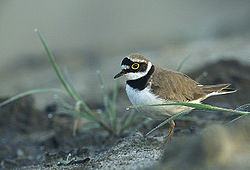 |
| Great knot | Calidris tenuirostris | 292,000-295,000 [192] | EN [192] |  [192] [192] | |  |
| Baird's sandpiper | Calidris bairdii | 300,000 [193] | LC [193] |  [193] [193] | Minimum estimate. European subpopulation estimated at 1,000-2,000 mature individuals. [193] |  |
| Whiskered tern | Chlidonias hybrida | 300,000-1,500,000 [194] | LC [194] |  [194] [194] | European subpopulation estimated at 133,000-215,000 mature individuals. [194] |  |
| Lesser sand plover | Charadrius mongolus | 310,000-390,000 [195] | LC [195] | Unknown [195] | | 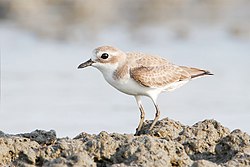 |
| Great snipe | Gallinago media | 310,000-570,000 [196] | NT [196] |  [196] [196] | Equal to 204,000-379,000 mature individuals. [196] |  |
| Red-necked stint | Calidris ruficollis | 315,000 [197] | NT [197] | Unknown [197] | |  |
| Sabine's gull | Xema sabini | 340,000 [198] | LC [198] |  [198] [198] | Minimum estimate is for mature individuals only. European subpoluation estimated at 2,100-4,100 mature individuals. [198] | 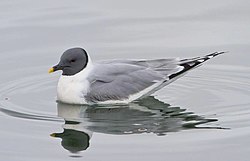 |
| Heermann's gull | Larus heermanni | 350,000 [199] | NT [199] | Unknown [199] | Estimate for mature individuals only. [199] | 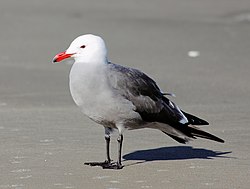 |
| Marbled murrelet | Brachyramphus marmoratus | 350,000-420,000 [200] | EN [200] |  [200] [200] | Equal to 240,000-280,000 mature individuals. Estimate comes from individual estimates in Alaska, British Columbia, Washington, Oregon and California. [200] |  |
| Eurasian stone-curlew | Burhinus oedicnemus | 360,000-589,999 [201] | LC [201] |  [201] [201] | Preliminary estimate for mature individuals only. Europe subpopulation is estimated at 107,000-176,000 mature individuals. [201] |  |
| Lesser yellowlegs | Tringa flavipes | 400,000 [202] | LC [202] |  [202] [202] | Equal to 270,000 mature individuals. [202] |  |
| Long-billed dowitcher | Limnodromus scolopaceus | 400,000 [203] | LC [203] | Unknown [203] | Minimum estimate. [203] |  |
| Pomarine jaeger | Stercorarius pomarinus | 400,000 [204] | LC [204] |  [204] [204] | Preliminary estimate for mature individuals only. European subpopulation estimated at 40,000 mature individuals. [204] |  |
| Arctic jaeger | Stercorarius parasiticus | 400,000-560,000 [205] | LC [205] |  [205] [205] | Preliminary estimate for mature individuals only. European subpopulation estimated at 79,800-112,000 mature individuals. [205] |  |
| Glaucous gull | Larus hyperboreus | 400,000-1,500,000 [206] | LC [206] |  [206] [206] | European subpopulation estimated at 93,000-270,000 mature individuals. [206] |  |
| Common ringed plover | Charadrius hiaticula | 415,000-1,400,000 [207] | LC [207] |  [207] [207] | European subpopulation estimated at 280,000-426,000 mature individuals. [207] |  |
| Common greenshank | Tringa nebularia | 440,000-1,500,000 [208] | LC [208] |  [208] [208] | European subpopulation estimated at 197,000-405,000 mature individuals. [208] |  |
| Black guillemot | Cepphus grylle | 400,000-1,499,999 [209] | LC [209] | Unknown [209] | For mature individuals only. Very preliminary estimate based on a European subpopulation of 304,000-742,000 mature individuals. [209] |  |
| American herring gull | Larus smithsonianus | 430,000-520,000 [210] | LC [210] |  [210] [210] | |  |
| Black-winged stilt | Himantopus himantopus | 450,000-780,000 [211] | LC [211] |  [211] [211] | European subpopulation estimated at 108,000-151,000 mature individuals. [211] |  |
| American avocet | Recurvirostra americana | 460,000 [212] | LC [212] |  [212] [212] | Estimate for mature individuals only. [212] |  |
| Ruddy turnstone | Arenaria interpres | 460,000-730,000 [213] | LC [213] |  [213] [213] | Equal to 300,000-500,000 mature individuals. European subpopulation estimated at 71,800-154,000 mature individuals. [213] | 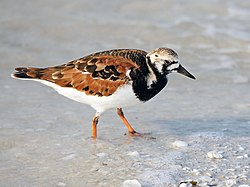 |
| Sandwich tern | Thalasseus sandvicensis | 490,000-640,000 [214] | LC [214] |  [214] [214] | Equal to 325,000-430,000 mature individuals. European subpopulation estimated at 160,000-295,000 mature individuals. [214] | 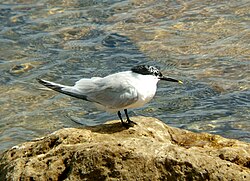 |
| Semipalmated plover | Charadrius semipalmatus | 500,000-1,000,000 [215] | LC [215] |  [215] [215] | Minimum estimate. [215] | 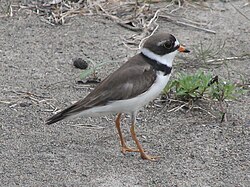 |
| Great black-backed gull | Larus marinus | 500,000-999,999 [216] | LC [216] | Unknown [216] | European subpopulation estimated at 360,000-400,000 individuals. [216] |  |
| Double-striped thick-knee | Burhinus bistriatus | 500,000-4,999,999 [217] | LC [217] |  [217] [217] | Estimate is for mature individuals only. [217] | 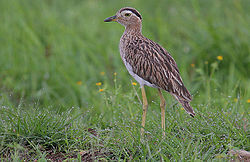 |
| Eurasian oystercatcher | Haematopus ostralegus | 500,000-999,999 [218] | NT [218] |  [218] [218] | |  |
| Northern jacana | Jacana spinosa | 500,000-4,999,999 [219] | LC [219] | Unknown [219] | Estimate for mature individuals only. [219] |  |
| Glaucous-winged gull | Larus glaucescens | 570,000 [220] | LC [220] |  [220] [220] | Minimum estimate. [220] |  |
| White-cheeked tern | Sterna repressa | 600,000 [221] | LC [221] |  [221] [221] | Equal to 400,000 mature individuals. [221] |  |
| Bridled tern | Sterna anaethetus | 610,000-1,500,000 [222] | LC [222] | Unknown [222] | Equal to 400,000-1,000,000 mature individuals. [222] |  |
| Black-tailed godwit | Limosa limosa | 614,000-809,999 [223] | NT [223] |  [223] [223] | | 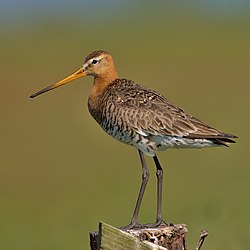 |
| Sanderling | Calidris alba | 620,000-700,000 [224] | LC [224] | Unknown [224] | European subpopulation is 50,100-100,000 mature individuals. [224] | 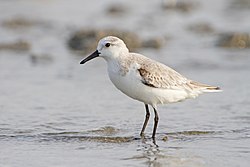 |
| California gull | Larus californicus | 621,000 [225] | LC [225] |  [225] [225] | |  |
| Grey plover | Pluvialis squatarola | 738,000-935,000 [226] | LC [226] |  [226] [226] | Equal to 490,000-630,000 mature individuals. European subpopulation is 10,000-20,000 mature individuals. [226] |  |
| Upland sandpiper | Bartramia longicauda | 750,000 [227] | LC [227] |  [227] [227] | Estimate is for mature individuals only. [227] | 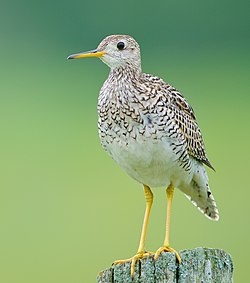 |
| Black tern | Chlidonias niger | 800,000-1,750,000 [228] | LC [228] |  [228] [228] | European subpopulation estimated at 149,000-308,000 mature individuals. [228] | 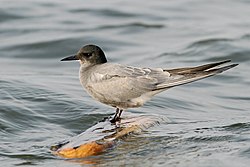 |
| Eurasian curlew | Numenius arquata | 835,000-1,310,000 [229] | NT [229] |  [229] [229] | |  |
| Red knot | Calidris canutus | 891,000-979,000 [230] | NT [230] |  [230] [230] | Minimum estimate. [230] |  |
| Lesser black-backed gull | Larus fuscus | 940,000-2,070,000 [231] | LC [231] |  [231] [231] | European subpopulation estimated at 1,200,000-1,400,000 individuals. [231] |  |
| Razorbill | Alca torda | 979,000-1,020,000 [232] | NT [232] |  [232] [232] | |  |
| African jacana | Actophilornis africanus | 1,000,000 [233] | LC [233] |  [233] [233] | |  |
| Killdeer | Charadrius vociferus | 1,000,000 [234] | LC [234] |  [234] [234] | | 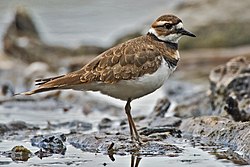 |
| Jack snipe | Lymnocryptes minimus | 1 000 000 [235] | LC [235] |  [235] [235] | Minimum estimate. [235] |  |
| Franklin's gull | Larus pipixcan | 1,000,000-1,490,000 [236] | LC [236] |  [236] [236] | | 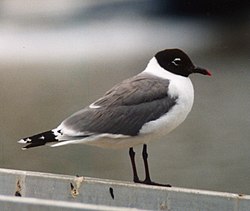 |
| Ancient murrelet | Synthliboramphus antiquus | 1,000,000-2,000,000 [237] | LC [237] |  [237] [237] | |  |
| Whimbrel | Numenius phaeopus | 1,000,000-2,300,000 [238] | LC [238] |  [238] [238] | European subpopulation estimated at 687,000-805,000 mature individuals. [238] |  |
| Common redshank | Tringa totanus | 1,000,000-3,499,999 [239] | LC [239] | Unknown [239] | European subpopulation estimated at 680,000-968,000 mature individuals. [239] | 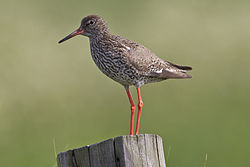 |
| Curlew sandpiper | Calidris ferruginea | 1,085,000-1,285,000 [240] | NT [240] |  [240] [240] | | 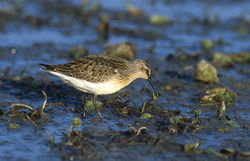 |
| Bar-tailed godwit | Limosa lapponica | 1,099,000-1,149,000 [241] | NT [241] |  [241] [241] | |  |
| Black-tailed gull | Larus crassirostris | 1,100,000 [242] | LC [242] |  [242] [242] | Minimum estimate. [242] |  |
| Horned puffin | Fratercula corniculata | 1,200,000 [243] | LC [243] |  [243] [243] | Minimum estimate. Equal to 800,000 mature individuals. [243] |  |
| Lesser noddy | Anous tenuirostris | 1,200,000 [244] | LC [244] |  [244] [244] | Minimum estimate. [244] |  |
| Brown noddy | Anous stolidus | 1,200,000-2,100,000 [245] | LC [245] |  [245] [245] | Equal to 800,000-1,400,000 mature individuals. [245] | 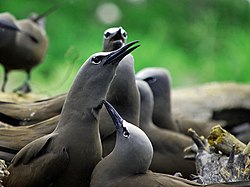 |
| Green sandpiper | Tringa ochropus | 1,200,000-3,600,000 [246] | LC [246] |  [246] [246] | European subpopulation estimated at 1,230,000-2,100,000 mature individuals. [246] |  |
| Black noddy | Anous minutus | 1,300,000 [247] | LC [247] |  [247] [247] | Estimate is for mature individuals only. [247] |  |
| Rhinoceros auklet | Cerorhinca monocerata | 1,300,000 [248] | LC [248] |  [248] [248] | Minimum estimate. [248] | 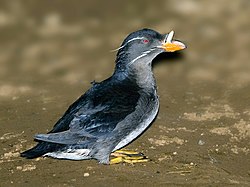 |
| European golden-plover | Pluvialis apricaria | 1,300,000-1,750,000 [249] | LC [249] |  [249] [249] | European subpopulation estimated at 1,890,000-2,600,000 individuals. [249] |  |
| Red phalarope | Phalaropus fulicarius | 1,300,000-2,999,999 [250] | LC [250] | Unknown [250] | European subpopulation estimated at 1,100-3,400 mature individuals. [250] |  |
| Parakeet auklet | Aethia psittacula | 1,400,000 [251] | LC [251] |  [251] [251] | Estimate for mature individuals only. [251] |  |
| Little stint | Calidris minuta | 1,500,000-1,600,000 [252] | LC [252] |  [252] [252] | Equal to 1,000,000-1,100,000 mature individuals. European subpopulation is 96,400-152,000 mature individuals. [252] | 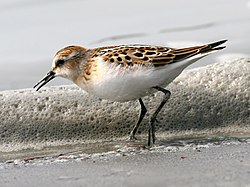 |
| Ruff | Calidris pugnax | 1,500,000-9,999,999 [253] | LC [253] |  [253] [253] | Preliminary estimate based on European population. [253] |  |
| European herring gull | Larus argentatus | 1,590,000-1,830,000 [254] | LC [254] |  [254] [254] | Equal to 1,060,000-1,220,000 mature individuals. [254] | 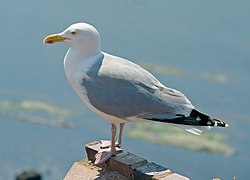 |
| Common tern | Sterna hirundo | 1,600,000-3,600,000 [255] | LC [255] | Unknown [255] | |  |
| Arctic tern | Sterna paradisaea | 2,000,000 [256] | LC [256] |  [256] [256] | Minimum estimate. European subpopulation estimated at 1,130,000-1,810,000 mature individuals. [256] |  |
| Wilson's snipe | Gallinago delicata | 2,000,000 [257] | LC [257] |  [257] [257] | Estimate is for mature individuals only. [257] |  |
| Semipalmated sandpiper | Calidris pusilla | 2,200,000 [258] | NT [258] |  [258] [258] | |  |
| Common gull | Larus canus | 2,500,000-3,700,000 [259] | LC [259] | Unknown [259] | European subpopulation estimated at 1,280,000-2,160,000 mature individuals. [259] |  |
| Ring-billed gull | Larus delawarensis | 2,550,000 [260] | LC [260] |  [260] [260] | |  |
| Common sandpiper | Actitis hypoleucos | 2,600,000-3,200,000 [261] | LC [261] |  [261] [261] | European subpopulation estimated at 1,590,000-2,920,000 mature individuals. [261] |  |
| Oriental pratincole | Glareola maldivarum | 2,900,000-3,000,000 [262] | LC [262] |  [262] [262] | | 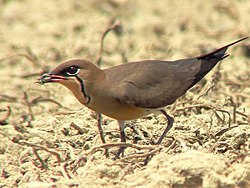 |
| Wood sandpiper | Tringa glareola | 3,100,000-3,500,000 [263] | LC [263] |  [263] [263] | European subpopulation estimated at 1,530,000-3,040,000 mature individuals. [263] |  |
| White-winged tern | Chlidonias leucopterus | 3,100,000-4,000,000 [264] | LC [264] |  [264] [264] | European subpopulation estimated at 133,000-347,000 mature individuals. [264] | 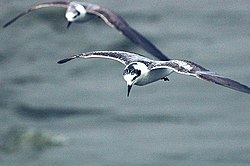 |
| Kelp gull | Larus dominicanus | 3,300,000-4,300,000 [265] | LC [265] |  [265] [265] | |  |
| Tufted puffin | Fratercula cirrhata | 3,500,000 [266] | LC [266] |  [266] [266] | Minimum estimate. Equal to 2,300,000 mature individuals. [266] |  |
| American woodcock | Scolopax minor | 3,500,000 [267] | LC [267] |  [267] [267] | Estimate is for mature individuals only. [267] | 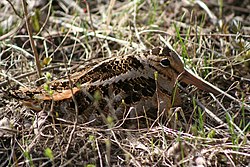 |
| Red-necked phalarope | Phalaropus lobatus | 3,600,000-4,500,000 [268] | LC [268] |  [268] [268] | European subpopulation estimated at 590,000-1,280,000 mature individuals. [268] |  |
| Dunlin | Calidris alpina | 4,300,000-6,799,999 [269] | LC [269] |  [269] [269] | European subpopulation is 853,000-1,120,000 mature individuals. [269] |  |
| Black-headed gull | Larus ridibundus | 4,800,000-8,900,000 [270] | LC [270] | Unknown [270] | European subpopulation estimated at 4,000,000-5,970,000 individuals, or 2,670,000-3,980,000 mature individuals. [270] | 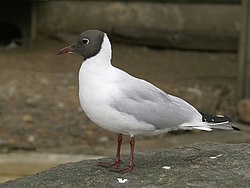 |
| Wattled jacana | Jacana jacana | 5,000,000-50,000,000 [271] | LC [271] |  [271] [271] | Estimate for mature individuals only. [271] |  |
| Southern lapwing | Vanellus chilensis | 5,000,000-50,000,000 [272] | LC [272] |  [272] [272] | Estimate is for mature individuals only. [272] |  |
| Cassin's auklet | Ptychoramphus aleuticus | 5,400,000 [273] | NT [273] |  [273] [273] | Equal to 3,600,000 mature individuals. [273] |  |
| Northern lapwing | Vanellus vanellus | 5,600,000-10,500,000 [274] | NT [274] |  [274] [274] | European subpopulation estimate is 3,190,000-5,170,000 mature individuals. [274] |  |
| Crested auklet | Aethia cristatella | 8,200,000 [275] | LC [275] |  [275] [275] | Minimum estimate. Equal to 5,500,000 mature individuals. [275] |  |
| Eurasian woodcock | Scolopax rusticola | 10,000,000-26,000,000 [276] | LC [276] |  [276] [276] | European subpopulation equals 13,800,000-17,400,000 mature individuals. [276] |  |
| Atlantic puffin | Fratercula arctica | 12,000,000-14,000,000 [277] | VU [277] |  [277] [277] | For mature individuals only. European subpopulation estimated at 9,550,000-11,600,000 mature individuals. [277] |  |
| Black-legged kittiwake | Rissa tridactyla | 14,600,000-15,700,000 [278] | VU [278] |  [278] [278] | European subpopulation estimated at 3,460,000-4,410,000 mature individuals. [278] |  |
| Common snipe | Gallinago gallinago | 15,000,000-29,000,000 [279] | LC [279] |  [279] [279] | Preliminary estimate for mature individuals only. [279] |  |
| Little auk | Alle alle | 16,000,000-36,000,000 [280] | LC [280] |  [280] [280] | European subpopulation estimated at 9,200,000-82,000,000 mature individuals, therefore the global population is likely larger. [280] |  |
| Common murre | Uria aalge | 18,000,000 [281] | LC [281] |  [281] [281] | Minimum estimate. European subpopulation estimated at 2,350,000-3,060,000 mature individuals. [281] |  |
| Least auklet | Aethia pusilla | 20,000,000 [282] | LC [282] |  [282] [282] | Estimate for mature individuals only. [282] | 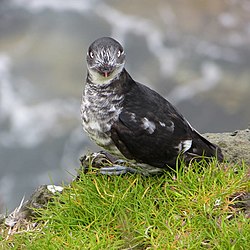 |
| Thick-billed murre | Uria lomvia | 22,000,000 [283] | LC [283] |  [283] [283] | Minimum estimate. European subpopulation estimated at 1,920,000-2,840,000 mature individuals. Russian subpopulation estimated at 10,000-1,000,000 breeding pairs. [283] |  |
| Sooty tern | Onychoprion fuscatus | 35,000,000 [284] | LC [284] | Unknown [284] | Equal to 23,000,000 mature individuals. [284] |  |
|











































































































































































































































































